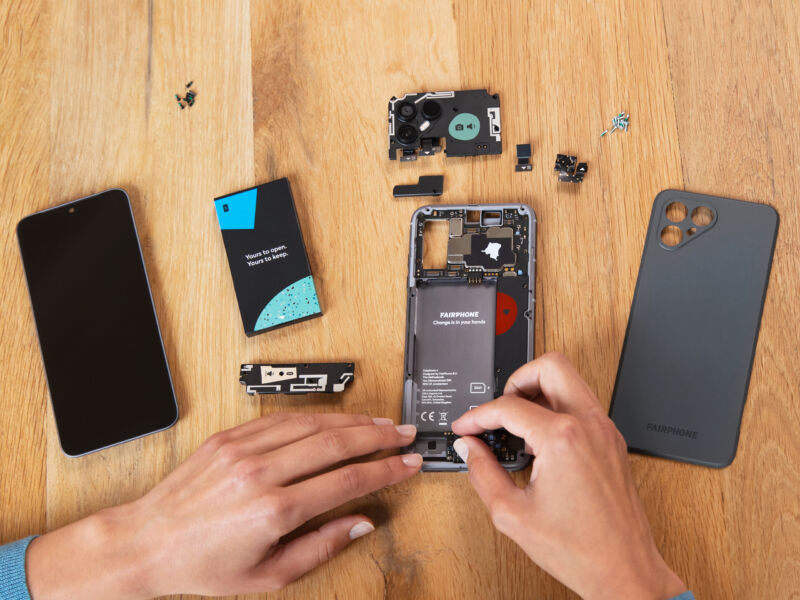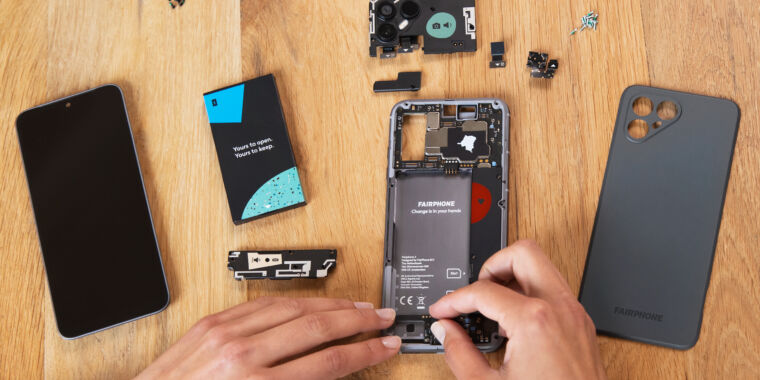
Fairphone
Whenever regulation passes that seems to herald the dawn of a new age of repairable devices, there is almost always a catch, a loophole, or at least an “it depends.” In the case of recent headline-grabbing battery legislation out of the European Union, we’re waiting to see what counts as “readily” when it comes to removing and replacing device batteries.
Last week, the European Parliament voted overwhelmingly in favor of new rules for handling batteries of all sizes in the EU, due to be implemented within 3.5 years of passage or as early as 2027. Along with measures addressing carbon footprints for electric vehicle and industrial batteries and stricter waste and recycling targets, there was a particular line in Article 11 regarding the “Removability and replaceability of portable batteries,” that likely got smartphone, tablet, and laptop manufacturer lobbyists moving:
Portable batteries incorporated in appliances shall be readily removable and replaceable by the end-user or by independent operators during the lifetime of the appliance, if the batteries have a shorter lifetime than the appliance, or at the latest at the end of the lifetime of the appliance.
“Readily replaceable,” as addressed in the next paragraph, is when, after removing a battery, you can substitute a similar battery “without affecting the functioning or the performance of that appliance.” For all the things specifically defined, outlined, and estimated in the 129-page “COM(2020) 798 final,” there’s not much more about what the phrase exactly means.
The word “appliance” is used in a broader context than you might assume, as laptops, printers, and cell phones are all included. As the European Parliament’s press office puts it, these regulations mean that portable batteries must be designed “in such a way that consumers can themselves easily remove and replace them.”
Later in the document, regarding battery disposal, it notes that end users have a responsibility to properly sort out those batteries that are “readily removable by the end user without the use of professional tools.” Does that clarify what “readily replaceable” means, or is this no-tools line specific only to keep people from throwing out batteries inside their electric shavers? There’s no clear answer yet.
There’s already wiggle room in pricing and “wet conditions”
Even assuming the European Parliament negotiates its proposal with the Council of the Europe Union and European Commission, the bodies reach an agreement, and the new rules are sent to all EU member countries for national implementation, there’s lots of wiggle room for manufacturers to work in. There’s also time for them to appeal and demand more time to reach these design goals.
As noted by Repair.EU, a leading European right-to-repair advocate, manufacturers must make batteries available as spare parts for five years after the last model is sold and at “a reasonable and non-discriminatory price.” That’s something that the group, along with other watchdogs, will have to monitor and report on to ensure compliance.
Some manufacturers are already eyeing an exemption for batteries used in “wet conditions” to opt out electric toothbrushes and possibly wearables like earbuds and smartwatches. The exemption is “based on unfounded safety claims,” states Thomas Opsomer, policy engineer for iFixit, in Repair.EU’s post.










